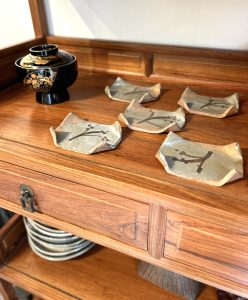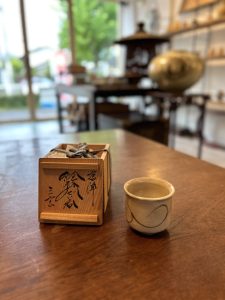器にはいつも助けられております(愛知県名古屋市千種区姫池通 骨董品買取 古美術風光舎)
2024.04.21
みなさまこんにちは。スタッフHでございます。
朝の快晴がうそのように名古屋の空はすっかり雲に覆われ、雨が降りはじめました。先日、中東地域で記録的な集中豪雨により道路や空港が水没するなどの被害が出ておりました。その地域の年間に降る水量の2倍ほどの雨が1日で降ったとか。
最近ニュースでは「記録的な」という言葉をよく耳にします。変わりやすい天候にやきもきしますが予報などに注視して行動しなければと思っております。
さて本日は雨の音を聞きながら、唐津焼の銘々皿を眺めております。柄や釉薬の掛かり具合が一枚一枚違っていて、使い道を想像をするだけで楽しめます。唐津焼は桃山時代からの歴史を誇る釉薬を施した陶器です。

唐津は佐賀県の北西部に位置し、「唐」は大陸、「津」は港という意味で大陸からの玄関口として「唐津」という地名が付けられました。唐津は古くから中国大陸や朝鮮半島との交流が盛んで、そこから渡ってきた職人から技術が伝わったとのことです。唐津焼は1580年代には日常使いの器として既に存在していたとされていますが、豊臣秀吉が朝鮮出兵(1592~1598)の際に連れ帰った陶工たにによりさらに技術が発展したと考えられています。
中でも薄茶の素地に草木などが描かれた絵唐津は、日本で初めて筆により文様を描かれた焼物だといわれています。素朴ながらも味わい深さがあります。
しだいに日常使いだけでなく茶道でも重用されるようになり、千利休に代表される茶人たちが、茶陶器を格付けして表した言葉に「一井戸(高麗)、二楽(京都)、三唐津」。和物茶碗では「一楽、二萩、三唐津」があり、いずれにも唐津焼は名品として数えられています。
朝鮮陶工たちは「蹴ろくろ」「登り窯」も日本に伝え、優れた品質の焼物を大量に作ることが可能となり、茶の湯の流行とともに唐津焼の名声も高まっていったといいます。
また、灰釉、鉄釉、藁灰釉など彩りの違う釉薬を施し、朝鮮唐津、斑唐津、黒唐津、三島手、粉引など多様性に富み、自由な発想を生かした焼物となりました。
江戸時代に鍋島藩が有田、伊万里の磁器生産に注力するようになり、唐津焼は衰退していったとされていますが、昭和に入り12代中里太郎右衛門が古唐津の技法を復活させ唐津焼を再興し、現在は再び個性豊かな作品が生み出されています。
唐津焼は他産地では効率化されて分業が進んでしまった各工程を、窯ごとに一貫して行っている作家が多いとのこと。素材に対するこだわりが強く、原料を近隣の山から採取し、釉薬には自然の植物を燃やした灰を使うそうです。素材の魅力を引き出すことを心掛け、登り窯による焼成も行われています。手がかかりますが、個性豊かな唯一無二の魅力がある作品が作られています。
唐津焼には「作り手八分、使い手二分」という言葉があり、使ってもらって初めて真に完成するという意味だそうです。ある作家の方が、「器が素敵だったと印象に残るのではなく、なんだか楽しい食事会だったなぁ」と思ってほしいとおっしゃっていました。食卓で主張し過ぎず、温かみがあり、なにより料理やお酒が映える器たち。釉薬がかかっているので扱いに気を遣い過ぎる必要がない。こんなに強い味方はない気がいたします。

それでは、また次の機会に。
Hello everyone. This is Staff H.
As if the clear skies of this morning were a lie, the skies over Nagoya are completely covered with clouds and it has started to rain. The other day, the Middle East region was hit by record-breaking torrential rains that flooded roads and airports. About twice as much rain fell in one day as the amount of water that falls in that region in a year.
We often hear the word “record-breaking” in the news these days. The changeable weather makes me nervous, but I think I must keep an eye on the forecast and act accordingly.
Today, while listening to the sound of rain, I am looking at Karatsu ware plates. Each piece has a different pattern and glaze, and I enjoy just imagining how they can be used. Karatsuyaki is a glazed pottery that boasts a history dating back to the Momoyama Period.
Karatsu is located in the northwestern part of Saga Prefecture. “Karatsu” means continent and “Tsu” means port, and the place was named “Karatsu” as a gateway from the continent. Karatsu has long been in contact with the Chinese mainland and the Korean peninsula, and techniques were introduced from artisans who came over from there. Karatsu ware is said to have already existed as daily-use vessels in the 1580s, but it is believed that the technique was further developed by the potters brought back by Toyotomi Hideyoshi during his invasion of Korea (1592-1598).
Ekaratsu, in which plants and trees are painted on a light brown base, is said to be the first pottery in Japan in which patterns were painted with a brush. The patterns are simple, yet deeply tasteful.
Gradually, it came to be used not only for daily use but also for tea ceremonies, and tea masters such as Sen no Rikyu ranked tea ceramics as “Ichido (Korai), Niraku (Kyoto), and San Karatsu”. For Japanese tea bowls, there are “Ichi-raku, Ni-hagi, and Sangaratsu,” and Karatsu ware is counted as a masterpiece in each of these categories.
Korean potters also introduced to Japan the “kicked potter’s wheel” and “climbing kiln,” which made it possible to produce large quantities of pottery of excellent quality, and the fame of Karatsuyaki increased along with the popularity of the tea ceremony.
The pottery also became rich in diversity and free in its conception, with glazes of different colors such as ash, iron, and straw ash glazes, as well as Korean karatsu, mottled karatsu, black karatsu, Mishimate, and kohiki (powder coating).
During the Edo period, the Nabeshima clan began to focus on porcelain production in Arita and Imari, and Karatsuyaki declined. However, in the Showa period (1926-1989), the 12th generation Nakazato Tarouemon revived Karatsu ware by reviving the old Karatsu technique, and today, Karatsu ware is once again being produced with a rich individuality.
In Karatsu-yaki, many artists consistently carry out each process at each kiln, which has become more efficient and the division of labor has progressed in other production areas. They are very particular about materials, collecting raw materials from nearby mountains and using ashes of burned natural plants for glaze. They also fire their pieces in a climbing kiln to bring out the charm of the materials. Although it is a labor-intensive process, it produces pieces that are rich in individuality and have a unique charm.
There is a saying in Karatsu-yaki, “The maker has eight parts and the user has two parts,” which means that a piece is truly complete only when it is used. One artist said that he wants people to think, “It was a somewhat enjoyable dinner party,” rather than to be impressed by how nice the dishes were. The dishes are not too assertive at the table, but have warmth and above all, look good with food and drinks. The glaze on the dishes means that you don’t have to be overly careful when handling them. I don’t think there is a stronger ally than this.
See you next time.
*******************
ご実家の整理やお片付けなどをされている方のご相談などが多くございます。
お片付けなどくれぐれもご無理のないようになさってくださいませ。
風光舎では古美術品や骨董品の他にも絵画や宝石、趣味のお品など様々なジャンルのものを買受しております。
お片付けをされていて、こういうものでもいいのかしらと迷われているものでも、どうぞお気軽にご相談下さいませ。
また風光舎は、出張買取も強化しております。ご近所はもちろん、愛知県内、岐阜県、三重県その他の県へも出張いたします。
まずは、お電話お待ちしております。
愛知県名古屋市千種区姫池通
骨董 買取【古美術 風光舎 名古屋店】
TEL052(734)8444
10:00-18:00 OPEN

